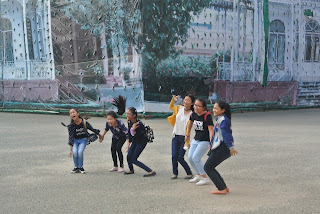Tuesday the 26th we fly from Saigon to Phnom Penh, the capital and largest city in Cambodia located on the banks of the Tonlé Sap and Mekong River. It has been the national capital since French colonization of Cambodia. Engineered by the French, Phnom Penh was once filled with beautiful tree-lined streets and colonial mansions. Today many of the old buildings exist, although they any are in disrepair.
Cambodia is about half the size of Vietnam with about a sixth of the number of people and a younger population. It is a much poorer country with its GDP about a tenth of Vietnam. Buddhism has existed in Cambodia since at least the 5th century, and in its earlier form was a type of Mahayana Buddhism. Theravada Buddhism has been the Cambodian state religion since the 13th century (excepting the Khmer Rouge period), and is currently estimated to be the faith of 95% of the population. It does have some practices from other beliefs such as the spirit house which is normally in the form of a miniature house or temple, and is mounted on a pillar or on a dais to provide a shelter for spirits that could cause problems for the people if not appeased. The shrines often include images of people and animals. Votive offerings are left at the house to win or regain the favor of the spirits. More elaborate installations include an altar for this purpose.
 |
| Spirit house |
We begin with a challenge but necessary visit to the infamous Tuol Sleng Prison, now a museum illustrating the atrocities committed by Pol Pot during the 1970's, and the nearby Choeung Ek, aka the "Killing Fields." The buildings at Tuol Sleng are preserved as they were left when the Khmer Rouge were driven out in 1979. The regime kept extensive records, including thousands of photographs. Several rooms of the museum are now lined, floor to ceiling, with black and white photographs of some of the estimated 20,000 prisoners who passed through the prison.
 | ||
Barbed wire in front of Tuol Sleng Prison
|
It is as difficult to imagine what happened in Cambodia as any genocide that has occurred in the world. After their defeat by the Vietnamese in 1979, they held onto Cambodia's UN seat until 1993, when the monarchy was restored and the country underwent a name change to the Kingdom of Cambodia. A year later, thousands of Khmer Rouge guerrillas surrendered themselves in a government amnesty. As our guide explained in the Buddhist way of thinking the amnisty was necessary for the country to move forward.



No comments:
Post a Comment